For the ultimate umami flavor, these delicious Mushroom Dumplings feature not one but three different varieties of mushrooms in the filling. These robust veggie dumplings are simply out of this world. They're super versatile and can be pan-fried, steamed, or boiled based on personal preference.
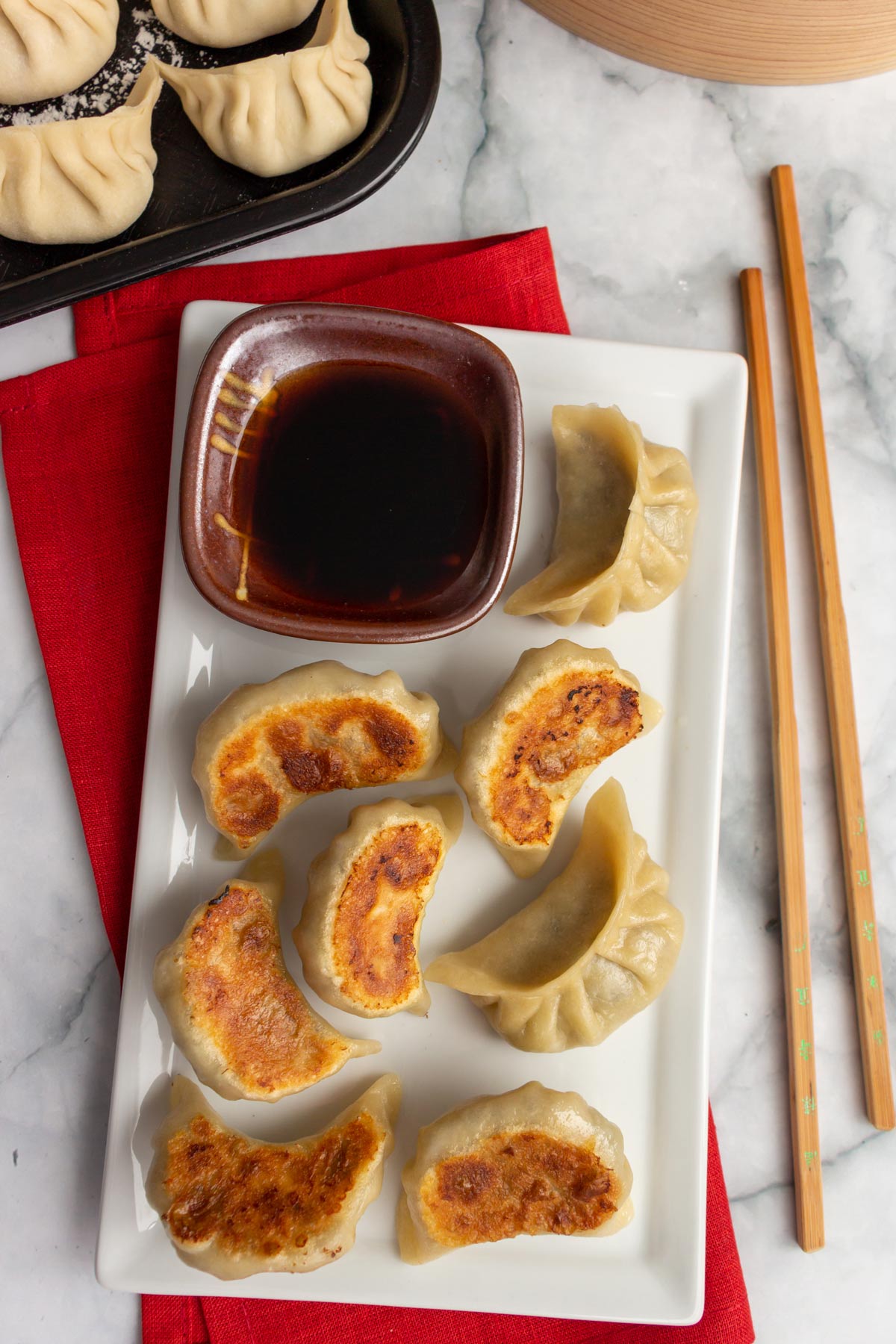
(This recipe was originally published in August 2014, but was updated with new photos and content in 2021).
In my substantial repertoire of dumpling recipes this one for three mushroom dumplings has been a favorite among family and friends for many years. What sets these apart from other veggie dumplings is that they are truly all about the mushrooms.
With three varieties of savory and flavorful mushrooms to balance each other out, you'll never need another recipe for mushroom dumplings once you try this one. Get creative with the recipe by trying different types of dough (or different colors) or use different cooking methods to discover your new favorite winning combination.
These earthy mushroom dumplings can be pan-fried to make potstickers, steamed, or boiled. Each cooking method will yield a slightly different result.
Mushroom potstickers are the perfect balance of crispy and chewy, while steamed mushroom dumplings are light and delicate. With boiled dumplings, instead of serving dipping sauce on the side I like drizzling it over the top!
Ingredient notes
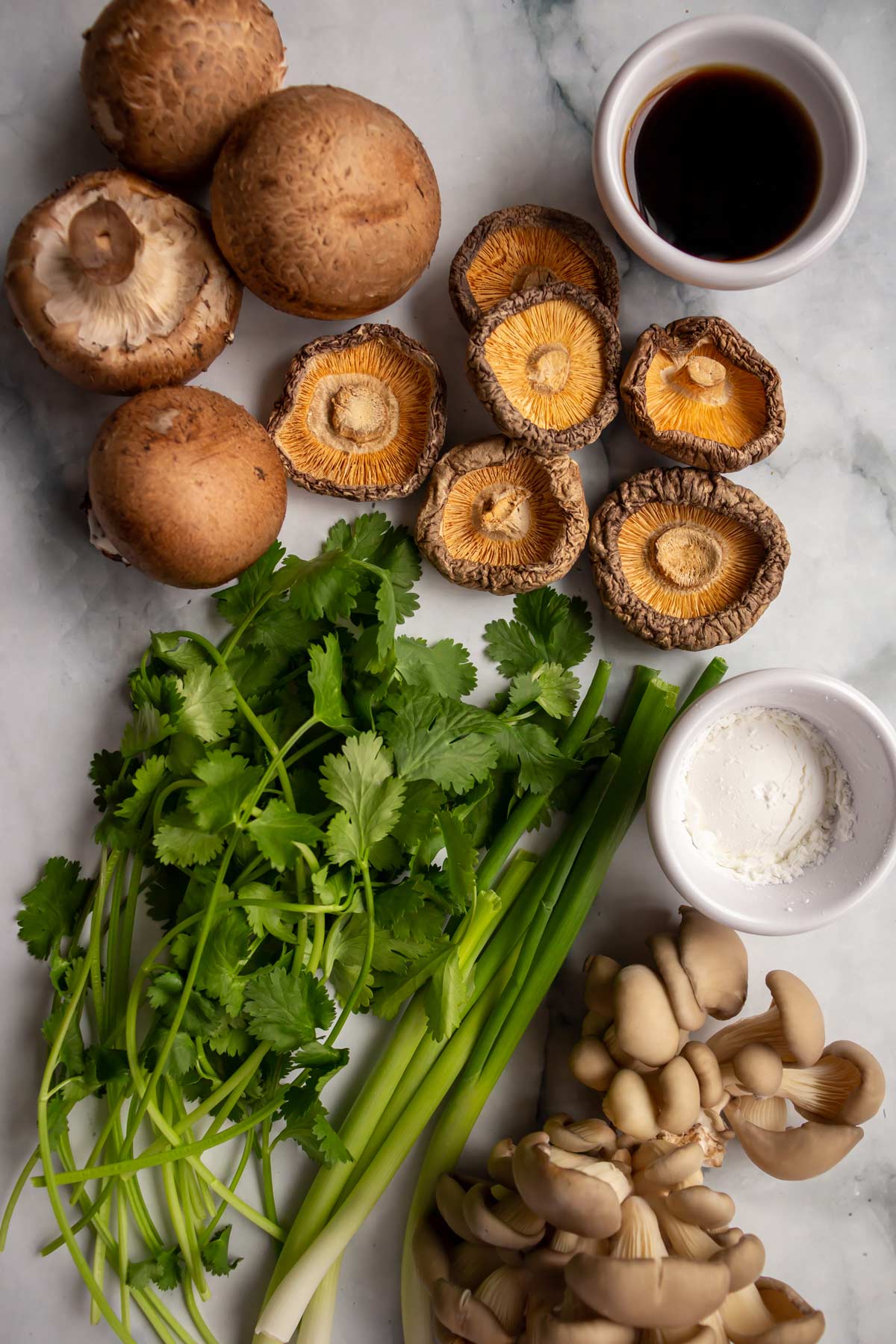
- Dried Shiitake Mushrooms: These are a workhorse in Chinese cuisine. They will last for a long time in your pantry and are very versatile in various Chinese recipes, like these Vegetable Dumplings. You'll get the best price for dried shiitake mushrooms at Asian markets, but they are also available at Whole Foods, specialty markets, and online.
- Oyster or Enoki Mushrooms: In addition to dried shiitakes and cremini mushrooms, the third variety of mushrooms in these dumplings is oyster or enoki mushrooms. Oyster mushrooms are my preferred choice because they are more readily available in some grocery stores and don't necessarily require a trip to the Asian market. Enoki mushrooms are a bit less common in my experience, but I have found them at local Asian markets. Use whichever you prefer or have access to.
- Oyster Sauce or Vegetarian Stir-Fry Sauce: Oyster sauce is another popular ingredient in many Chinese recipes. It contains oyster extractives so it is not vegetarian. Use a vegetarian oyster sauce or vegetarian stir-fry sauce to make these mushroom dumplings vegetarian.
- Shaoxing Rice Wine: Another staple in Chinese cooking, Shaoxing rice wine is available at Asian markets and online. You may substitute dry sherry if it's unavailable.
- Cilantro (Fresh Coriander): This is one of two herbs (the other being green onions or scallions) in the filling for these three mushroom dumplings. Some people have an aversion to cilantro. There is a minimal amount in this recipe, but if you don't like cilantro you may replace it with extra scallions.
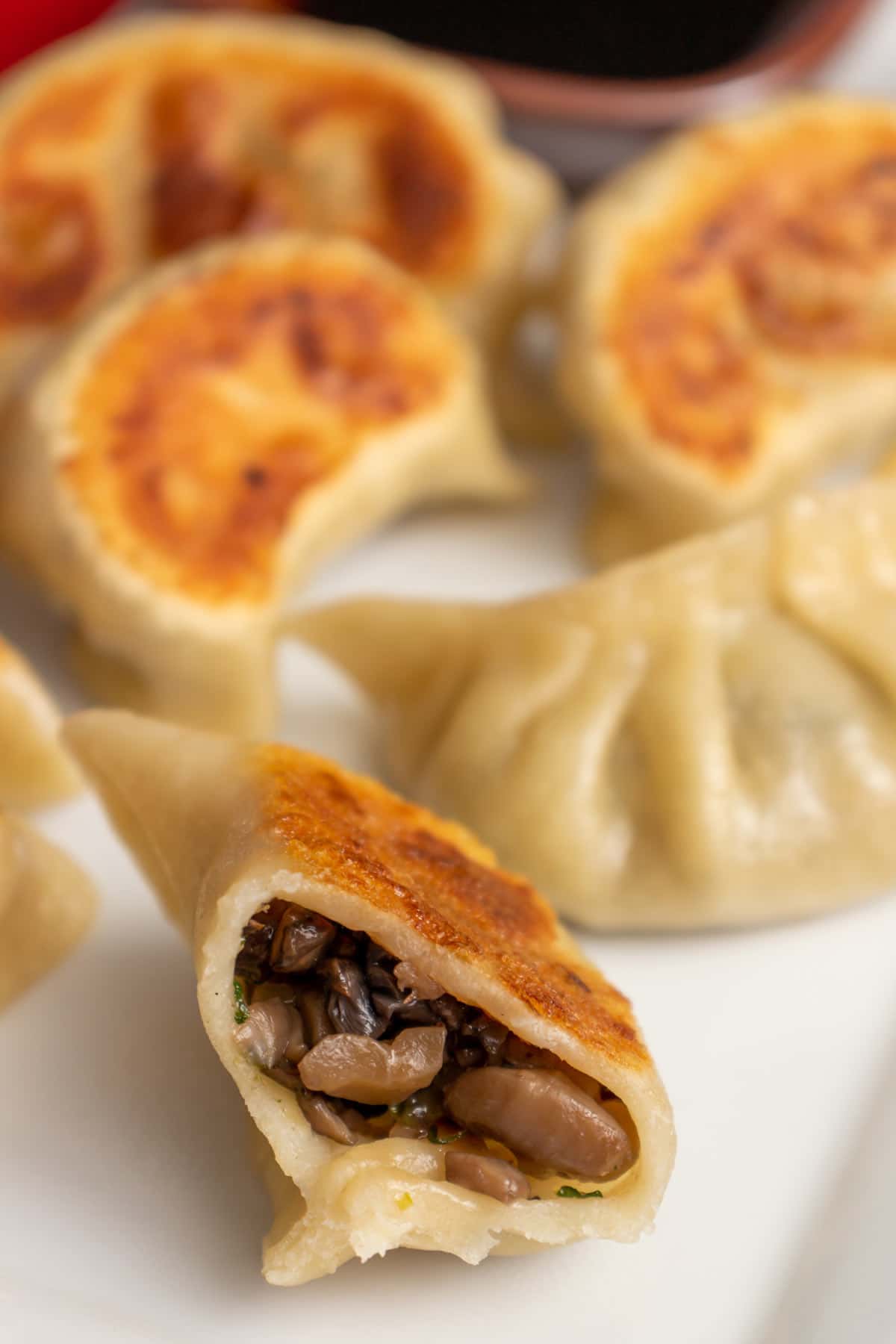
How to make them
Put the shiitake mushrooms in a small bowl and cover with hot water. Let them stand for 30 to 45 minutes to soften. Then drain and reserve the soaking liquid, squeezing the caps to remove excess liquid.
Cut off and discard the hard stems, then finely chop the caps. Transfer to a bowl with the remaining chopped mushroom varieties.
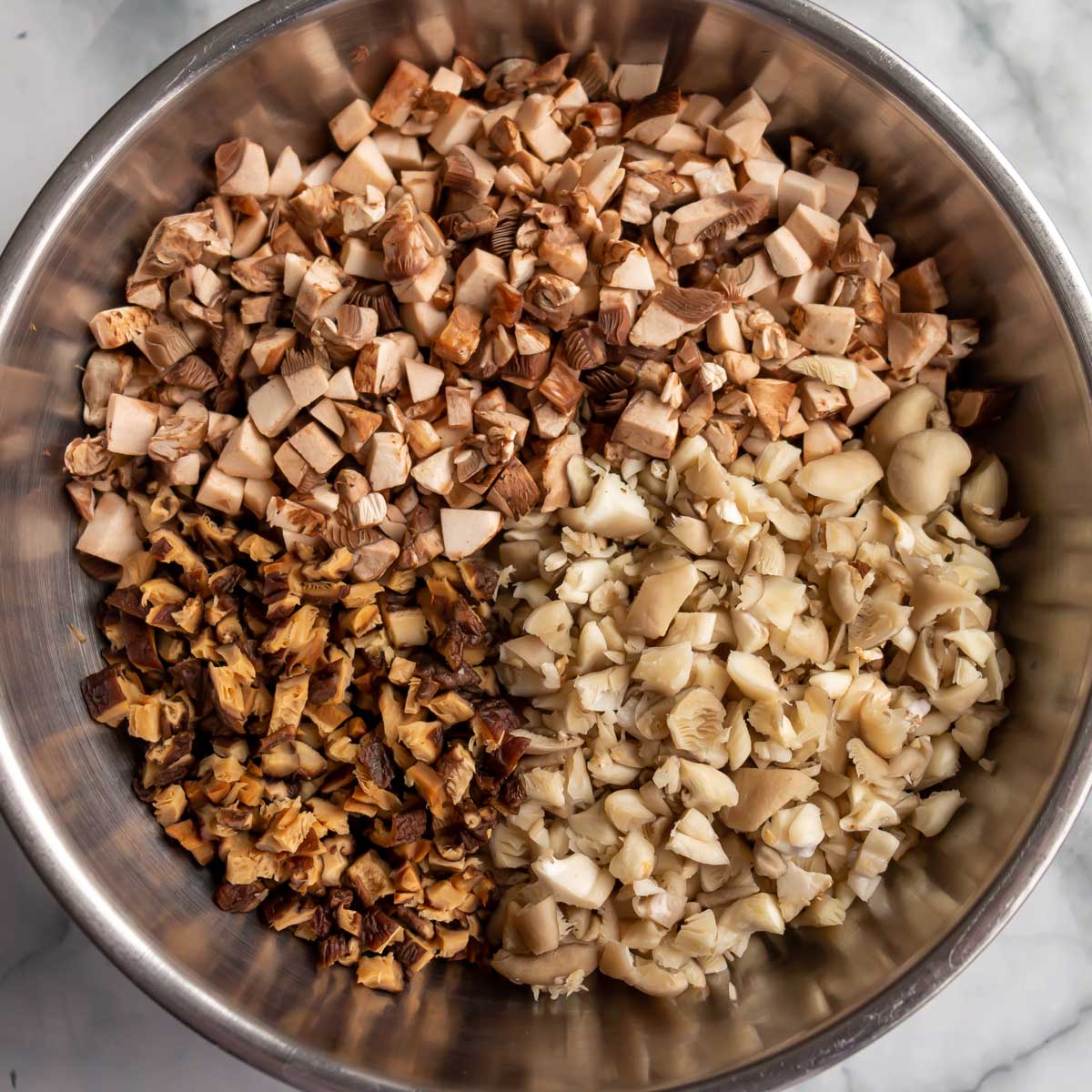
In a small bowl combine the cornstarch with 2 tablespoons of the mushroom soaking liquid and set aside. Discard the remaining soaking liquid.
Heat a wok or large skillet over medium-high heat, then add oil. Add mushrooms, scallions, and cilantro and stir-fry over medium heat.
Reduce the heat to low, stir in the oyster sauce, rice wine, soy sauce, sugar, and pepper. Give the cornstarch mixture a stir and add it to the pan. Cook for 1 minute longer, or until the sauce has thickened. Cool the filling before forming the mushroom dumplings.
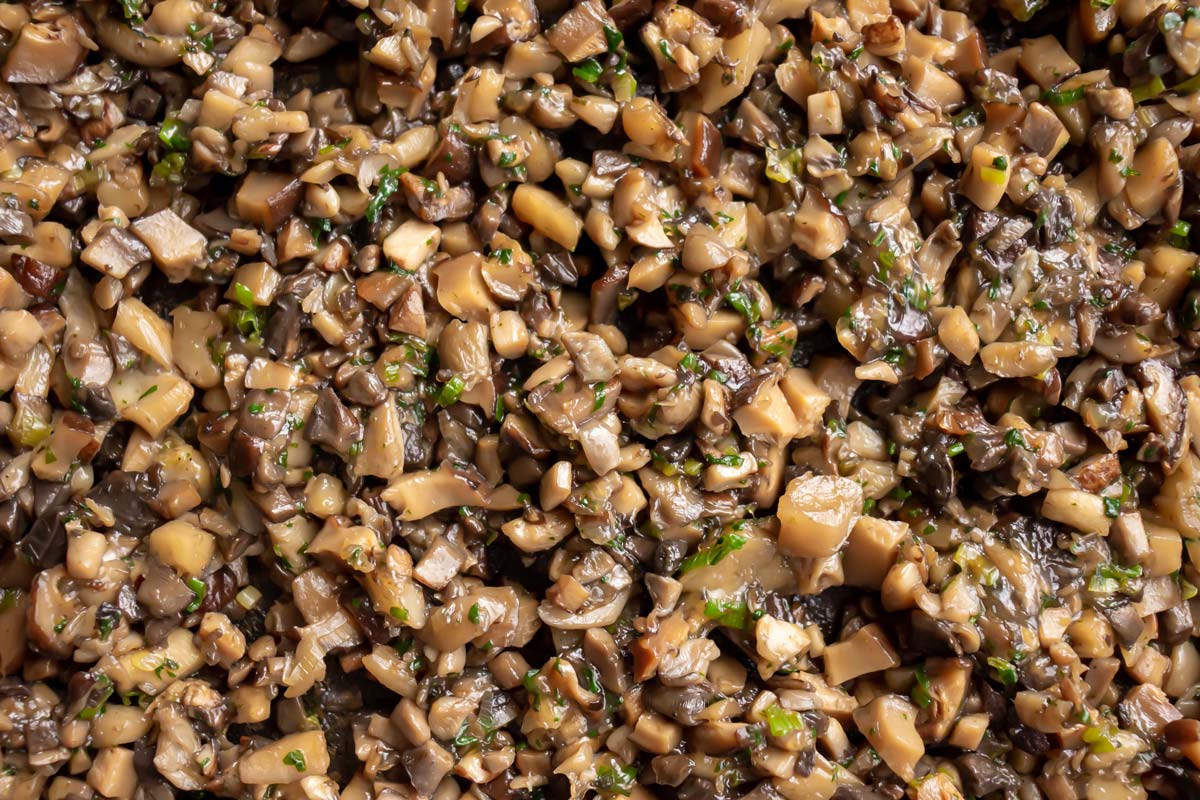
Next, make the dough. In a large mixing bowl add flour and just-boiled water. Mix together until you have a lot of lumpy bits, then knead the hot dough in the bowl until the dough comes together and then becomes smooth and elastic.
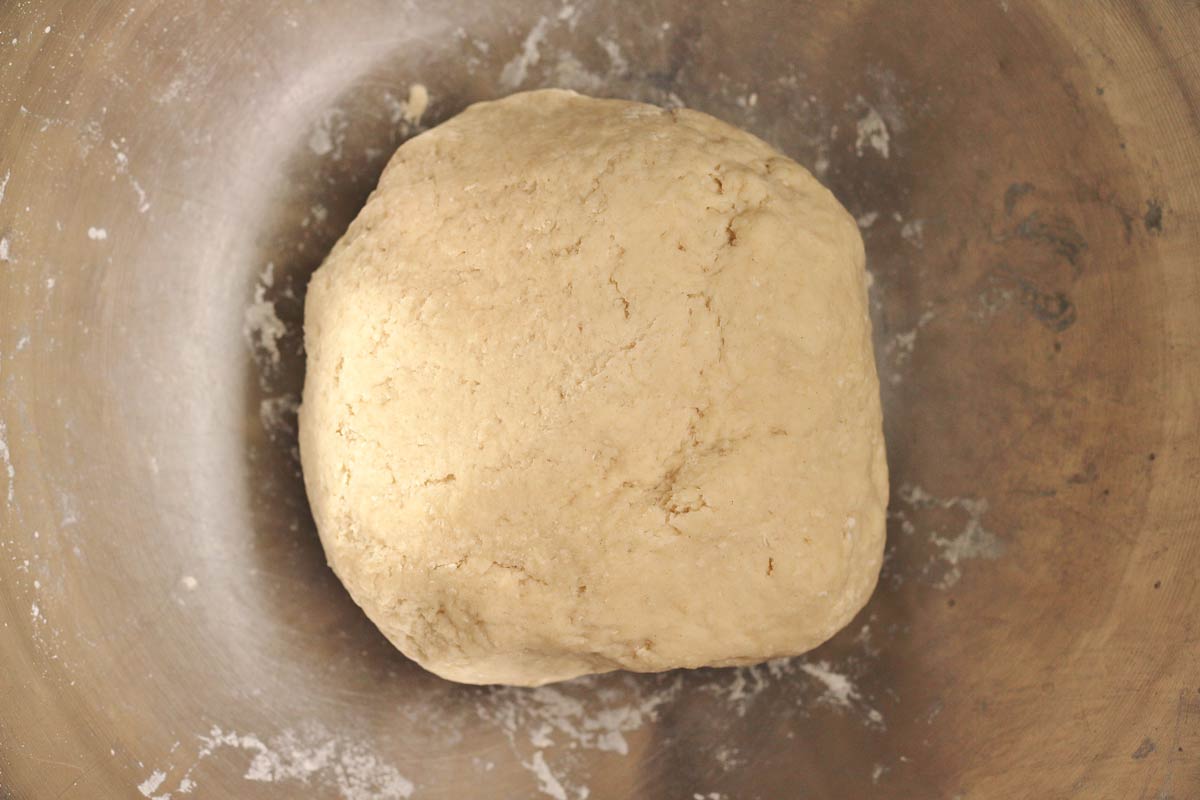
Place dough in a zip-top bag, seal tightly, pressing out excess air, and set aside at room temperature for 15 minutes up to 2 hours. The dough will steam up the bag and soften.
After resting, remove the dough from the bag and cut it in quarters. Put ¾ back in the bag, squeezing out the air and sealing it closed to prevent drying.
Then, roll the dough into a 1-inch-thick log and cut into 8 pieces. Take each piece of dough and press each cut end in flour, lightly pressing the dough to about ¼ inch thick and set aside.
Next roll out each disk aiming for wrappers that are about 3 ¼ inches in diameter. When a batch of wrappers is formed, fill them before making wrappers out of the other portions of dough.
To assemble a mushroom dumpling, scoop about 1 tablespoon of filling into the center of the wrapper. Pleat the edges to close. Pinch once in the middle (PHOTO 1), then begin pleating one side until you reach the end (PHOTO 2).
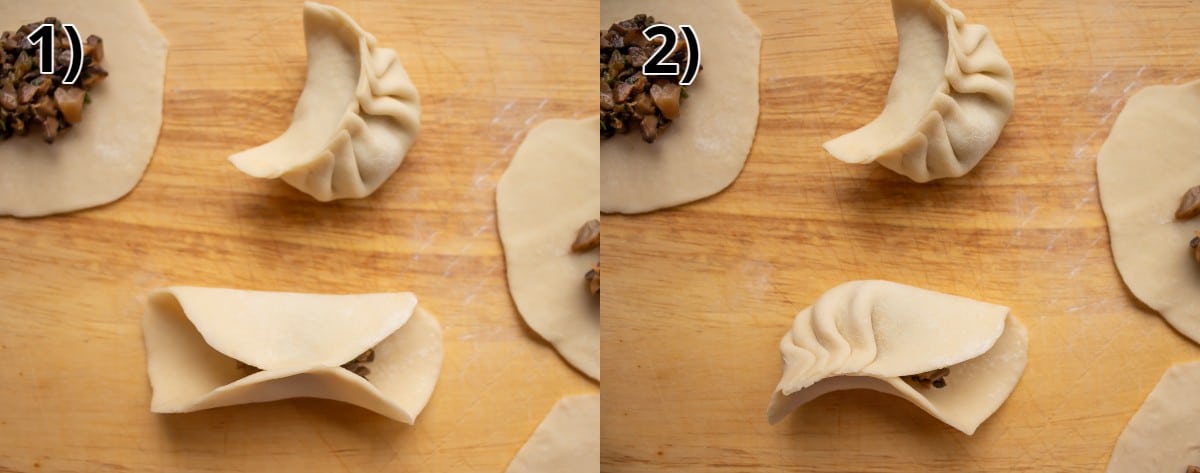
Finish pleating the other side until the dumpling is sealed closed and forms a crescent shape.
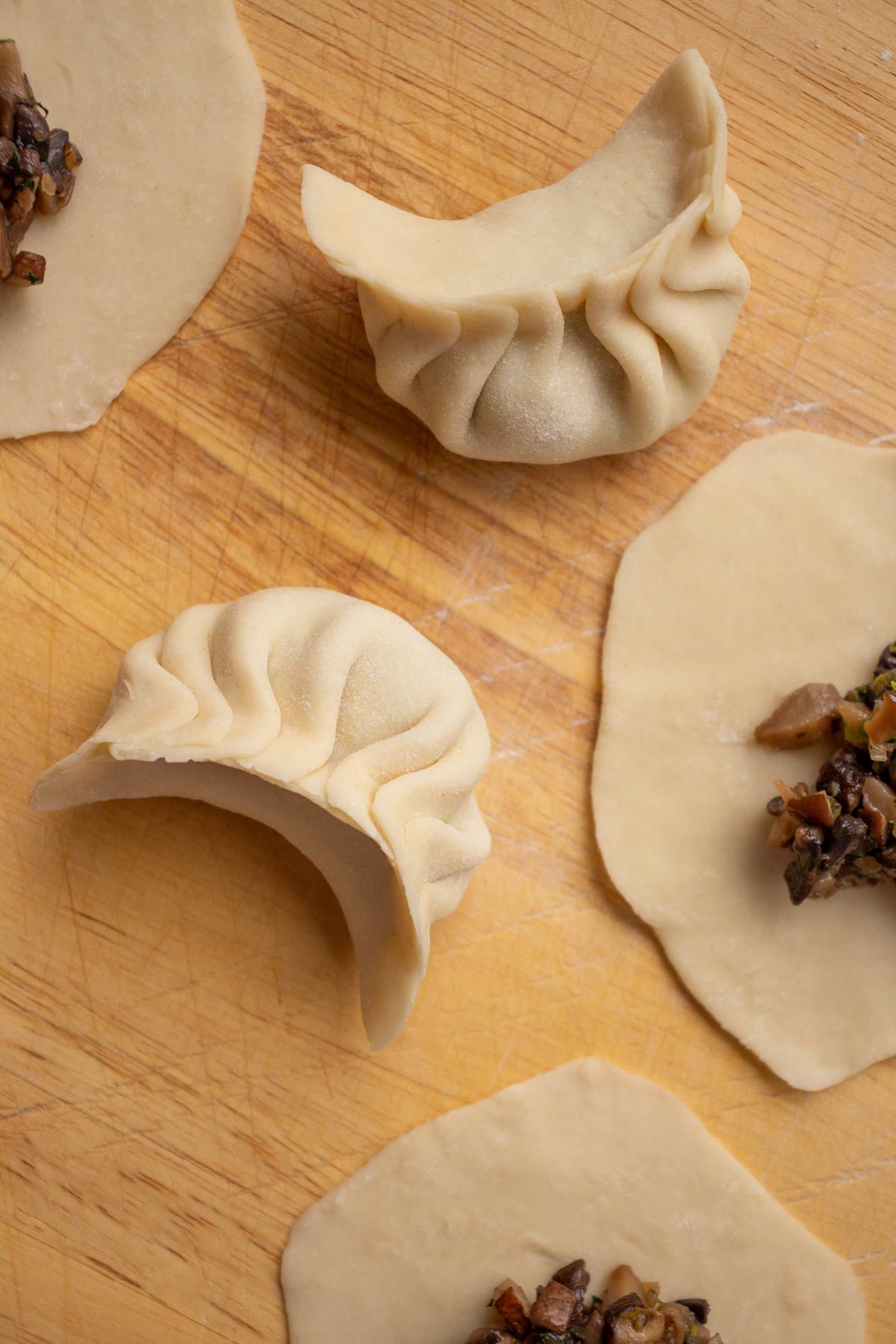
Place finished dumplings on a floured or parchment paper-lined baking sheet or cafeteria tray. Repeat with the remaining wrappers and dough, spacing out dumplings about ½ inch apart.
When all the mushroom dumplings are assembled, they can be covered with plastic wrap and refrigerated for several hours and can be cooked straight from the refrigerator.
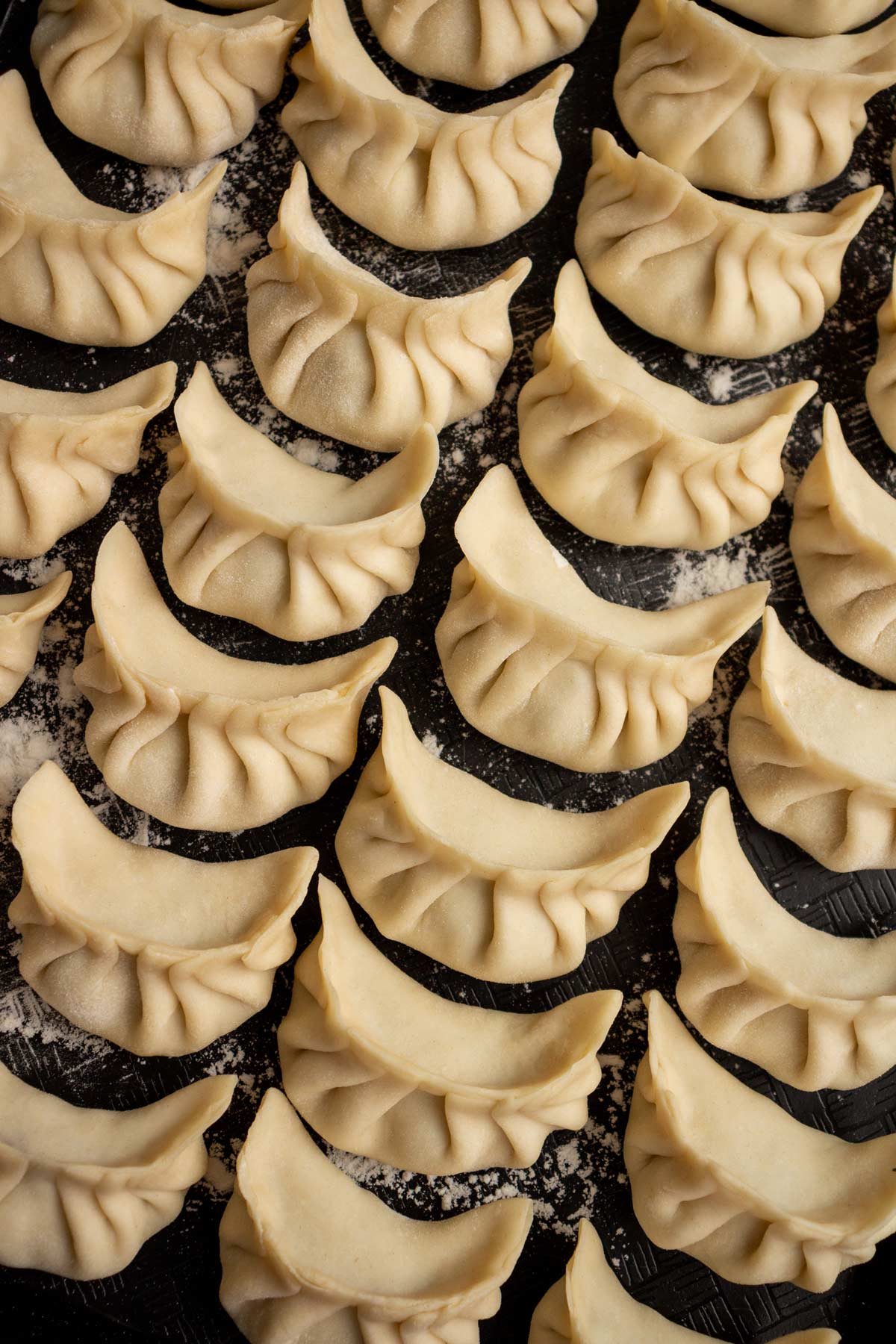
These savory morsels are very versatile. Pan-fry, steam, or boil these mushroom dumplings based on your personal preference. Thorough instructions on each cooking method is provided in the recipe card below.
My personal favorite is pan-frying (aka potstickers), as it yields the most dynamic texture (both chewy and crispy), but steaming and boiling work well too and are a bit lighter.
Serve with dipping sauce on the side. I recommend a classic combination of two parts soy sauce and one part rice wine vinegar for the perfect balance of salt and acid.
Please scroll to the bottom of the post for the full recipe (in a printable recipe card) including ingredient amounts and detailed instructions.
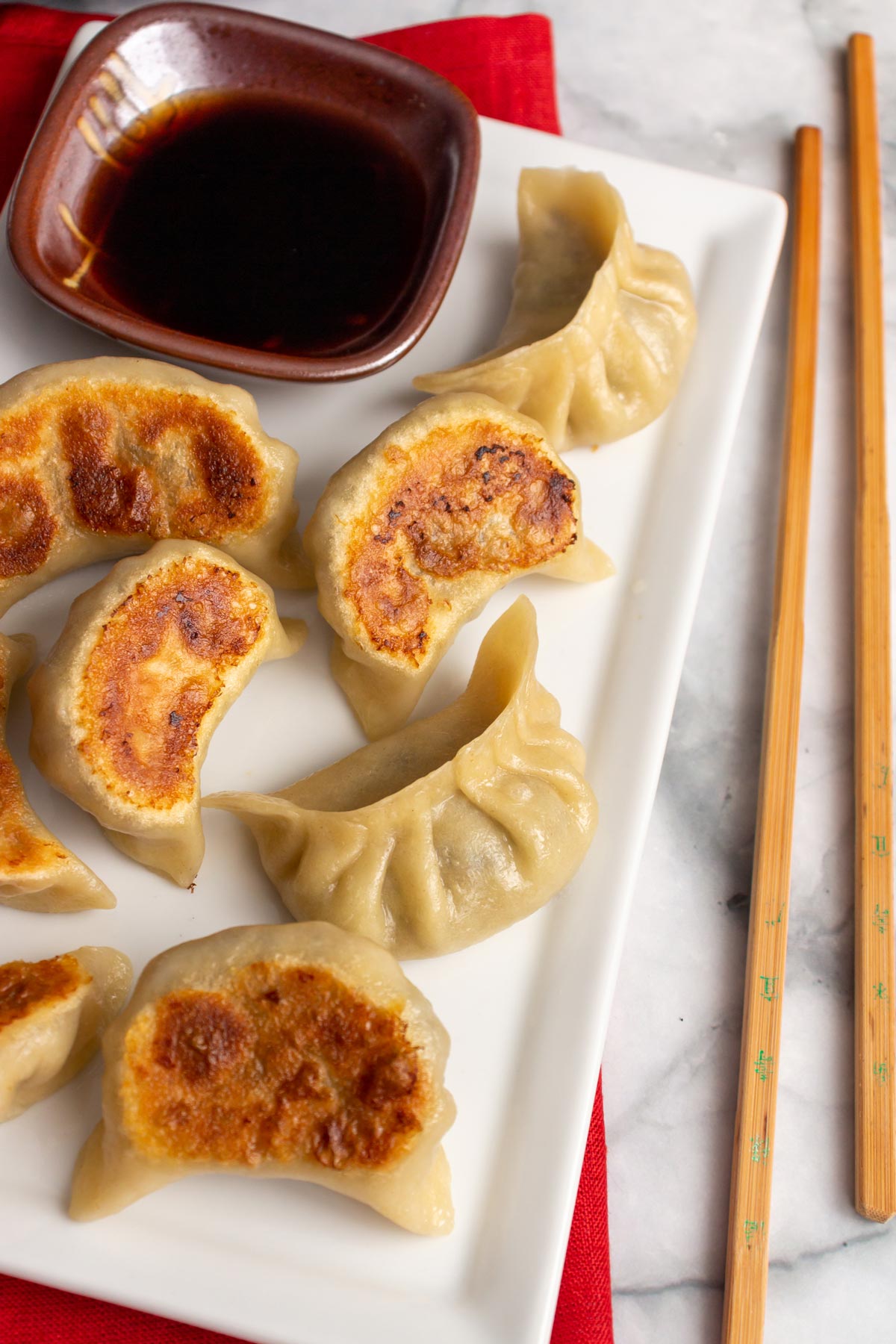
Expert tips and FAQ
Get a head start on these mushroom dumplings! The filling can be made in advance, covered and refrigerated up to one day ahead.
Here are a couple easy ways to transform your simple white dumpling dough into colorful creations. For orange dough replace the just-boiled water with just-boiled 100% carrot juice. Meanwhile, for bright gold dough add 1 teaspoon ground turmeric into the flour before adding the water. The dough will develop its vibrant color as it sits. To make green dough follow the instructions in this Fish Dumplings recipe. Or perhaps try red dough by replacing the just-boiled water with just-boiled 100% tomato juice.
To make lighter pan-fried mushroom dumplings and avoid too much oil splatter, I like to spray a bit of avocado oil into my nonstick pan instead of drizzling. This uses a bit less oil but still evenly distributes it in the pan, yielding beautiful golden dumpling bottoms with a fraction of the fat and mess.
To make these mushroom dumplings with wheat starch dough, follow the dough recipe for these Chinese Chive Dumplings. Divide the dough into 24 or 32 pieces (I sometimes like to make them larger with this dough) and shape them into simple half moons with ruffled tops like these Spicy Beef Dumplings or pleat them as desired. If using wheat starch dough, make sure you steam all the dumplings before refrigerating or freezing them, as this type of dough needs to be cooked immediately.
Yes, you may freeze assembled uncooked dumplings on their baking sheet until hard (about 1 hour). Then transfer frozen dumplings to a zip-top freezer bag, pressing out excess air before sealing, and freeze for up to 1 month. To cook after freezing, partially thaw, using your finger to smooth over any cracks that may have formed during freezing, before cooking.
Potstickers is a term used specifically for pan-fried dumplings. All potstickers are dumplings but not all dumplings are considered potstickers because dumplings can be cooked with different methods other than pan-frying.
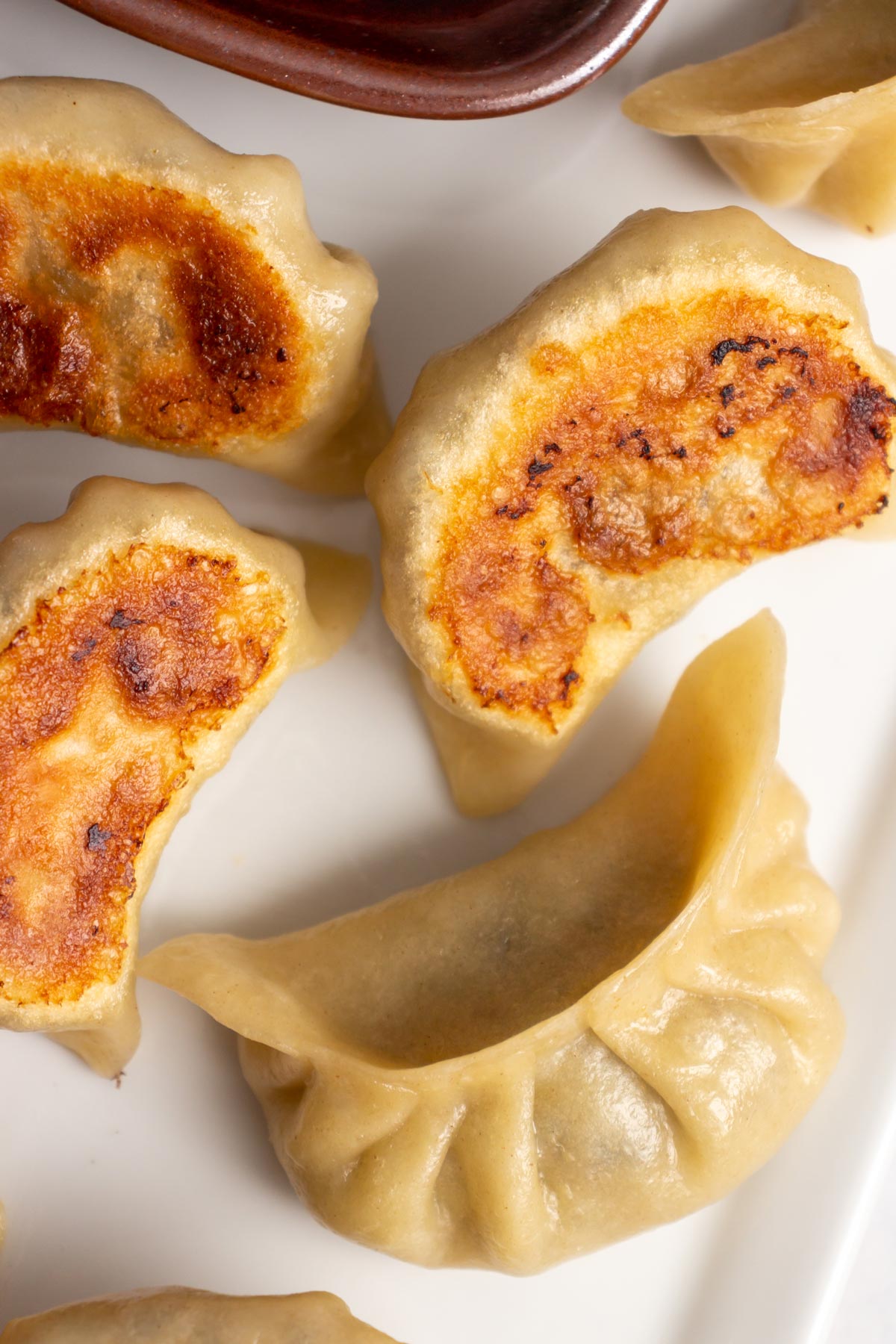
Other recipes you may like
- Easy Edamame Dumplings
- Pea Shoots and Leek Dumplings
- Vegetable Potstickers
- Carrot Dumplings
- Brussels Sprouts and Bacon Dumplings
- Khinkali (Georgian Dumplings)
Tried this recipe? Please leave a star ⭐️⭐️⭐️⭐️⭐️ rating in the recipe card below and/or a review in the comments section further down the page. You can also follow me on social media on Facebook, Instagram, and Pinterest!
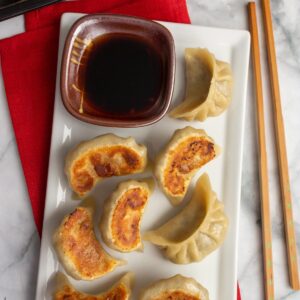
Three Mushroom Dumplings
Ingredients
Three Mushroom Filling:
- 6 dried shiitake mushrooms
- 1 tablespoon cornstarch
- 2 teaspoons peanut or vegetable oil
- 6 ounces fresh cremini (baby portabella) mushrooms finely chopped
- 5 ounces fresh oyster or enoki mushrooms finely chopped
- 2 scallions white and green parts, finely sliced
- 2 tablespoons finely chopped fresh cilantro (if you are a cilantro-hater, use extra scallions instead)
- 1 tablespoon oyster sauce or vegetarian stir-fry sauce
- 2 teaspoons Shaoxing rice wine or dry sherry
- 1 ½ teaspoons soy sauce
- ¼ teaspoon sugar
- ⅛ teaspoon ground white or black pepper
Flour Dough:
- 10 ounces (285 grams / 2 cups) all-purpose flour
- About ¾ cup just-boiled water (boil water, then let it sit for a minute off the heat before measuring)
Instructions
- To make the filling: Put the shiitake mushrooms in a small bowl and cover with hot water. Let them stand for 30 to 45 minutes to soften. Drain the mushrooms, squeezing them out, and reserving the soaking liquid. Cut off and discard the hard stems, then finely chop the caps.
- In a small bowl combine the cornstarch with 2 tablespoons of the mushroom soaking liquid and set aside. Discard the remaining soaking liquid.
- Heat a wok or large skillet over medium-high heat, then add the oil. When it is almost smoking, add the fresh and dried mushrooms, scallions, and cilantro and stir-fry over medium heat for 4 minutes, or until most of the liquid has evaporated.
- Reduce the heat to low, stir in the oyster sauce, rice wine, soy sauce, sugar, and pepper. Give the cornstarch mixture a stir and add it to the pan, cooking for 1 minute longer, or until the sauce has thickened. Let the filling cool before forming the dumplings. The filling can be covered and refrigerated up to one day ahead.
- To make the dough: Place a large mixing bowl over a damp paper towel on your work surface, to keep in place while mixing. Add the flour and make a well. Use a wooden spoon to mix the flour while you add the water in a steady stream. Mix together until you have a lot of lumpy bits, then knead the hot dough in the bowl until the dough comes together. Add water by the teaspoon if the dough does not come together.
- Continue kneading the dough on a lightly floured surface (only flour if necessary, and do so sparingly) for a couple more minutes until the dough is smooth and elastic (or finish kneading directly in the bowl if it's large enough). The dough should bounce back when pressed with your finger, but leave a light impression of your finger. Place dough in a zip-top bag, seal tightly, pressing out excess air, and set aside at room temperature for 15 minutes up to 2 hours. The dough will steam up the bag and soften. After resting, the dough can be used right away, or refrigerated overnight and returned to room temperature before using.
- To assemble the dumplings: Remove the dough from the bag, turning the bag inside out if the dough is sticky. Put the dough on a lightly floured surface and cut it in quarters. Put ¾ back in the bag, squeezing out the air and sealing it closed to prevent drying.
- Roll the dough into a 1-inch-thick log and cut into 8 pieces (cut in half, then cut each half in half, and so on to create pieces that are even in size. The tapered end pieces should be cut slightly larger). If your pieces are oval, stand them on one of the cut ends and gently squeeze with your fingers to make them round, like a scallop. Take each piece of dough and press each cut end in flour, lightly pressing the dough to about ¼ inch thick and set aside.
- Next, flatten each dough disk into a thin circle, about ⅛ inch thick, either with a tortilla press (lined with plastic wrap), or with a heavy flat-bottomed object like a frying pan (also lined with plastic). Alternatively, use a dowel (which is a good lightweight rolling pin alternative for fast and flexible dumpling making) to lightly roll out each disc into an ⅛ inch thick circle.
- To finish the wrappers, place wrappers one at a time on your work surface, and flour only if sticky. Imagine a quarter-size circle in the center of the dough. This is what the Chinese call the “belly” of the wrapper. You want to create a wrapper that is larger than its current size, but still retaining a thick “belly” in the center. This ensures an even distribution of dough when the dumpling is sealed. Use the rolling pin to apply pressure to the outer ½-to-¾-inch border of the wrapper. Roll the rolling pin in short downward strokes with one hand while the other hand turns the wrapper in the opposite direction. Aim for wrappers that are about 3 ¼ inches in diameter. When a batch of wrappers is formed, fill them before making wrappers out of the other portions of dough.
- Line a baking sheet with parchment paper or dust generously with flour.
- To assemble a dumpling, scoop about 1 tablespoon of filling into the center of the wrapper, pressing down gently to compact and keeping about ½ to ¾ inch of wrapper clear on all sides. Bring up the edges to seal into a half-moon shape or pleat the edges as desired.
- Place finished dumplings on the prepared baking sheet. Repeat with the remaining wrappers and dough, spacing out dumplings about ½ inch apart. Keep the finished dumplings covered with a dry kitchen towel.
- When all the dumplings are assembled, they can be covered with plastic wrap and refrigerated for several hours and can be cooked straight from the refrigerator.
- To pan-fry the dumplings, use a medium or large nonstick skillet with a lid. Heat the skillet over medium-high heat and add 1 ½ tablespoons oil for a medium skillet and 2 tablespoons for a large one. Place the dumplings 1 at a time, sealed edges up, in a winding circle pattern. The dumplings can touch. Fry the dumplings for 1 to 2 minutes until they are golden or light brown on the bottom.
- Holding the lid close to the skillet to lessen splatter, use a measuring cup to add water to a depth of roughly ¼ inch (about ⅓ cup water). The water will immediately sputter and boil vigorously. Cover with a lid, lower the heat to medium, and let the water bubble away for 8 to 10 minutes, until it is mostly gone. When you hear sizzling noises, remove the lid as most of the water is now gone. Let the dumplings fry for another 1 or 2 minutes, or until the bottoms are brown and crisp. Turn off the heat and wait until the sizzling stops before using a spatula to transfer dumplings to a serving plate. Display them with their bottoms facing up so they remain crisp.
- To steam the dumplings, place the dumplings into a bamboo steamer lined with a perforated parchment circle or cabbage leaves (to keep the dumplings from sticking to the steamer) steam over boiling water for for about 8 minutes, or until slightly puffed and somewhat translucent. Remove the trays and place each atop a serving plate.
- To boil the dumplings, half-fill a large pot with water and bring to a boil over high heat (I like to salt the water, but it’s not necessary). Add half the dumplings, gently dropped each one into the water. Nudge them apart with a wooden spoon to keep them from sticking together or to the bottom of the pot. Return the water to a simmer and then lower the heat to maintain a simmer and gently cook the dumplings for about 8 minutes, or until they float to the surface, look glossy, and are puffed up and a tad translucent. Use a slotted spoon or skimmer to scoop the dumplings from the pot, a few at a time, pausing the spoon’s motion over the pot to allow excess water to drip back down before putting the dumplings on a serving plate. Cover the plate with a large inverted bowl to keep the dumplings warm. Return the water to a boil and cook the remaining dumplings. When done, return the first batch to the hot water to reheat for a minute or two. There is no need to reboil.
Notes
- Freeze the assembled uncooked dumplings on their baking sheet until hard (about 1 hour), transfer to a zip-top freezer bag, pressing out excess air before sealing, and frozen for up to 1 month. To cook after freezing, partially thaw, using your finger to smooth over any cracks that may have formed during freezing, before cooking.
- Here are a couple easy ways to transform your simple white dumpling dough into colorful creations. For orange dough replace the just-boiled water with just-boiled 100% carrot juice. For bright gold dough add ¾ teaspoon ground turmeric into the flour before adding the water. The dough will develop its vibrant color as it sits. For green dough follow the instructions in this Fish Dumplings recipe. Or perhaps try red dough by replacing the just-boiled water with just-boiled 100% tomato juice.
- To lighten my pan-fried mushroom dumplings and avoid too much oil splatter, I like to spray a bit of avocado oil into my nonstick pan instead of drizzling. This uses a bit less oil but still evenly distributes it in the pan, yielding beautiful golden dumpling bottoms with a fraction of the fat and mess.
- To make these mushroom dumplings with wheat starch dough, follow the dough recipe for these Chinese Chive Dumplings. Divide the dough into 24 or 32 pieces (I sometimes like to make them larger with this dough) and shape them into simple half moons with ruffled tops like these Spicy Beef Dumplings or pleat them as desired. If using wheat starch dough, make sure you steam all the dumplings before refrigerating or freezing them, as this type of dough needs to be cooked immediately.
- For the optimal dipping sauce, I recommend a classic combination of two parts soy sauce and one part rice wine vinegar for the perfect balance of salt and acid.
- Filling adapted from Dim Sum; dough/assembly from Asian Dumplings
Nutrition
*All nutritional information is based on third-party calculations and should be considered estimates. Actual nutritional content will vary with brands used, measuring methods, portion sizes and more.*

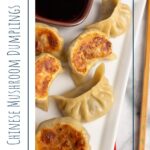






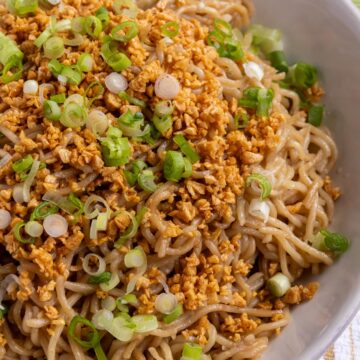
Camille says
One of my favorites of all your dumpling recipes!!